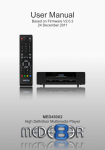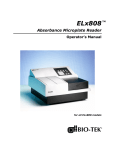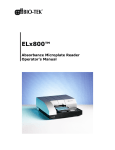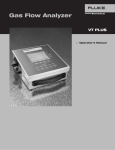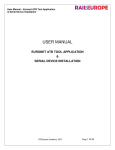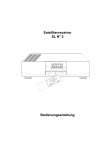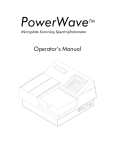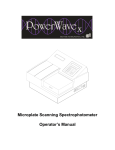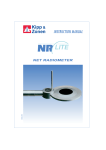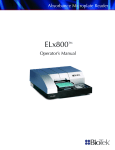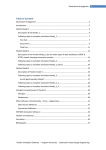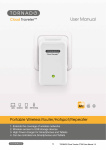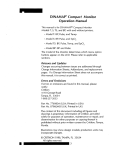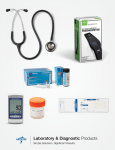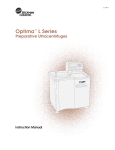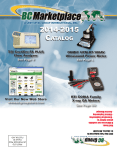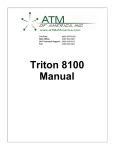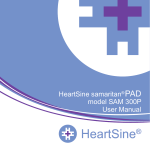Download NON-INVASIVE BLOOD PRESSURE MONITOR TESTER
Transcript
NON-INVASIVE BLOOD PRESSURE MONITOR TESTER BIO-TEK® INSTRUMENTS, INC. BP Pump NIBPM Tester Operator's Manual Manual P/N 2771000 Revision E May 1998 BP Pump User's Guide ii BP Pump User's Guide Notices © Copyright, 1995, Bio-Tek Instruments, Inc. BIO-TEK®INSTRUMENTS, INC. Highland Park, Box 998 Winooski, Vermont 05404-0998 USA 802-655-4040 800-451-5172 800-24-BIOTK (Service) FAX: 802-655-7941 (Sales) 802-655-3399 (Service) All Rights Reserved This publication is protected by copyright and all rights are reserved. No part of this manual may be reproduced or transmitted in any form, or by any means electronic or mechanical, including photocopying and recording, for any purpose other than the purchaser's personal use without the written permission of the product /manufacturer. Restrictions and Liabilities Information in this document is subject to change, and does not represent a commitment by Bio-Tek Instruments, Inc. Changes made to the information in this document will be incorporated in new editions of the publication. No responsibility is assumed by Bio-Tek for the use or reliability of software or equipment that is not supplied by Bio-Tek, or its affiliated dealers. Trademarks Bio-Tek’s BP Pump and OTIS are registered trademarks of Bio-Tek Instruments, Inc. iii BP Pump User's Guide Revision Appendix Rev./Date Page Change A 5/92 -- First Issue B 8/92 1-3 1-4 ANSI/AAMISP reference deleted Reference to parallel printer deleted. 3-9,-10 Some values in Presets chart corrected. 4-3 Max. Pulse Volume value corrected. 4-3,-4,-5 BP value (Weak Pulse) in Presets mode table corrected. 5-3 Amplitude level swing value corrected. 5-4 Value for Amplitude tremor displacement (Tremor Artifact) corrected. 6-1 Reference to Compliance Test removed. 6-4 Reworded leak test section for clarity. 6-5 Added information to Overpressure Test section. 7-4 Changed Pulse Volume rate in Level 1 sample printout. 8-4 Added information in Line 2, Dump Command. 9-7 Corrected displacement value in "Use Configure..." section. 10-7 Added text for clarity; changed values to conform to Special Mode spec. B-5 Added Note (Simulation Mode). C 12/92 Doc Removed references to 100V and 220V line voltages D 06/95 1-10 Added ECG, Invasive BP connections 3-3, 3-10 3-11, 4-3 5-3 Added text on physiological and non-physiological BP simulations; added info that Tests mode zeros BP Outputs 6-3 B-6 Added text on zeroing BP Pump Added Electrical-ECG specs v-vii Added CE Mark/safety information; reformatted/edited text as needed. E iv Minor editing throughout to improve readability. 05/98 BP Pump User's Guide Based on the testing below, the system bears the CE mark. Electromagnetic Interference and Susceptibility EC EMC Directive 89/336/EEC EN 50081-1, Class A-Emissions This unit has been type tested by an independent testing laboratory and found to meet the requirements of EC Directive 89/336/EEC for Radiated Emissions and Line Conducted Emissions. Verification was to the limits and methods of EN 55011. This unit is classified as EN 55011, Group 1, Class A. Electromagnetic Interference Caution: Some types of monitor leads or BP cables may conduct internally generated radio frequency energy when connected to the BP Pump. Should you suspect or experience RF interference with other nearby equipment, use of a ferrite bead placed as close as possible to the BP Pump or shielded cables should reduce the problem. EN 50082-1 Immunity This unit was also tested and found to meet requirements for Electrostatic Discharge Susceptibility, Radiated Susceptibility, and Electrical Fast Transient/Burst Susceptibility. Verification of compliance was conducted to the limits and methods of EN 50082-1:1992, IEC 801-2, IEC 801-3, and IEC 801-4. EC Low Voltage Directive 73/23/EEC Safety This unit has been type tested and found to meet the requirements of International IEC 1010-1 (1990): "Safety requirement for electrical equipment for measurement, control and laboratory use. Part 1, General requirements."; and EN 61010-1: "Safety requirement for electrical equipment for measurement, control and laboratory use. Part 1, requirements." USA FCC Class A Warning: Changes or modifications to this unit not expressly approved by the manufacturer could void the user's authority to operate the equipment. This equipment has been tested and found to comply with the limits for a Class A digital device, pursuant to Part 15 of the FCC Rules. These limits are designed to provide reasonable protection against harmful interference when the equipment is operated in a commercial environment. Like all similar equipment, this equipment generates, uses, and can radiate radio frequency energy and, if not installed and used in accordance with the instruction manual, may cause harmful interference to radio communications. Operation of this equipment in a residential area could cause interference, in which case the user will be required to correct the interference at his own expense. v BP Pump User's Guide Canadian Department of Communications Class A This digital apparatus does not exceed Class A limits for radio emissions from digital apparatus set out in the Radio Interference Regulations of the Canadian Department of Communications. Le present appareil numerique n'met pas du bruits radioelectriques depassant les limites applicables aux appareils numerique de la Class A prescrites dans le Reglement sur le brouillage radioelectrique edicte par le ministere des Communications du Canada. Environmental Operating Specifications Safety This unit is designed to be operated under the following conditions: • Altitude up to 2,000 meters • 18º to 40º C • Relative humidity less than 80% for temperatures up to 31º C to a relative humidity of 50% at a temperature of 40º C • Mains supply voltage fluctuations not greater than 5% of the nominal voltage • Transient overvoltage category II • Pollution degree of 1 • This unit is classified to installation category (overvoltage category) II. • This unit has a power rating (requirement) of 86 volts/amps (V/A). • The mains fuse(s) requirements of this unit are as follows: • 120 VAC: one fuse rated at 2 amps, size 3 AG, type T (SB) • 240 VAC: two fuses rated at 1 amp, size 3 AG, type T (SB) Caution: vi • To ensure proper cooling, be sure to rest the unit on a hard, flat surface that will not block the air flow beneath. • The use of this product in any manner that is not specified by Bio-Tek Instruments will void the warranty, and could cause damage to the product as well as cause possible injury to the operator. • The BP Pump should not be left in Simulation Mode with more than 100 mmHg output. The unit may overheat. BP Pump User's Guide Safety Symbols The following warning and informational symbols may be found in various locations on the instrument. Only qualified personnel who recognize shock hazards and are familiar with the safety precautions should use this instrument. Read the manual carefully before operating this instrument. Alternating current Courant alternatif Dreiphasen-Wechselstrom Corriente Atterna Corrente alternata On (Supply) Marche (alimentation) Ein (Verbindung mit dem Netz) Connectado Chiuso Caution (Refer to accompanying documents) Attention (voir documents d'accompanement) Achtung siehe Begleitpapiere Atención (vease los documentos incluidos) Attenzione, consultare la doc annessa Note: The BP Pump contains a strong magnet which could cause damage to computer disks and other susceptible devices. Note: La pompe BP contient un aimant puissant, pouvant endommager les disques informatiques ou tout autre appareil sensible. Bemerkungen: Die BP Pümpe enthäit einen starken Magneten, der Compüter-Disketten und andere sensible Teile zerstören kann. Nota: La bomba BP contiene un potente imán que puede causar daños en los discos y otros equipos susceptibles. Nota: La pompa BP contiene una sorgente di campo magnetico ad alta intensità che potrebbe causare danni a dischi per computer e alle altre apparecchiature sensibili. Off (Supply) Arrest (alimentation) Aus (Trennung vom Netz) Desconectado Aperto (sconnessione dalla rete di alimentazione) vii BP Pump User's Guide viii BP Pump User's Guide Contents Chapter 1 TOC Overview Introducing the BP Pump.............................................................................................. Optional Accessories.................................................................................................... About this Manual......................................................................................................... Quick Installation / Operations Guide ........................................................................... Chapter 2 Installation 1-1 1-3 1-4 1-5 1-7 2-1 Unpacking and Incoming Inspection.............................................................................. 2-3 Connecting the BP Pump to the Blood Pressure Monitor (NIBPM) ............................... 2-5 Printer Setup.................................................................................................................. 2-6 Attaching the Parallel Cable .................................................................................... 2-6 Powering the Printer ................................................................................................ 2-7 Dip Switch Settings.................................................................................................. 2-7 Chapter 3 Guided Tour of BP Pump Functions 3-1 Modes and Functions ................................................................................................... 3-3 Getting Started: A Hands-On Approach ....................................................................... 3-4 Sample Session: Simulation Mode............................................................................... 3-6 BP Pump Functions...................................................................................................... 3-9 SIMLATION Mode ................................................................................................ 3-10 ARTIFACT Mode .................................................................................................. 3-11 TESTS Mode ........................................................................................................ 3-11 CONFIGURE Mode .............................................................................................. 3-11 Chapter 4 More on PRESETS Mode 4-1 Introduction.................................................................................................................... 4-3 Standard Pressures....................................................................................................... 4-4 Normal Sinus Rhythm ................................................................................................... 4-4 Irregular Pulse (Arrhythmia) .......................................................................................... 4-5 Respiratory Artifact ........................................................................................................ 4-6 ix BP Pump User's Guide Chapter 5 More on ARTIFACT Mode 5-1 Introduction.................................................................................................................... 5-3 Motion Artifacts.............................................................................................................. 5-4 Tremor Artifacts ............................................................................................................. 5-5 Adding Artifacts to Blood Pressure .......................................................................... 5-6 Artifact Levels .......................................................................................................... 5-6 Chapter 6 TESTS Mode and Monitor Evaluations 6-1 Overview........................................................................................................................ 6-3 Pressure Gauge Test .................................................................................................... 6-3 Pressure Source Test.................................................................................................... 6-4 Leak Test....................................................................................................................... 6-4 Overpressure Test......................................................................................................... 6-5 Suggestions for Troubleshooting NIBPMs..................................................................... 6-6 Suggestions for Evaluating Different NIBPMs ............................................................... 6-7 Routine Testing of NIBPMs ........................................................................................... 6-8 Non-Invasive BP Monitor Test Procedure ..................................................................... 6-9 Chapter 7 PRINT Mode 7-1 Overview........................................................................................................................ 7-3 The PRINT Function...................................................................................................... 7-3 Header, Statistics and Graphics ................................................................................... 7-4 Calculations in Statistics Printout .................................................................................. 7-4 Examples of Graphics Printouts .................................................................................... 7-5 Chapter 8 Computer Control The BP Pump Serial Port ............................................................................................. Hardware Description ................................................................................................... Requirements ............................................................................................................... Computer Control Protocol ........................................................................................... Command Port........................................................................................................ Commands ............................................................................................................. Keyboard Port Mode............................................................................................... Getting Started ............................................................................................................. Sample Session ........................................................................................................... Chapter 9 Q & A: Monitor and Tester Issues 8-1 8-3 8-3 8-3 8-4 8-4 8-4 8-5 8-5 8-6 9-1 Blood Pressure Issues ................................................................................................. 9-3 Cuff Issues.................................................................................................................... 9-5 x BP Pump User's Guide Chapter 10 Service 10-1 Service and Safety ...................................................................................................... 10-3 Electrical Safety........................................................................................................... 10-3 Magnetic Media Warning............................................................................................. 10-3 Replacing the Fuse...................................................................................................... 10-4 Configuring the BP Pump for Different Voltages ......................................................... 10-5 Special Mode Diagnostics ........................................................................................... 10-7 Pressure Calibration .................................................................................................... 10-9 Returning the BP Pump for Service........................................................................... 10-10 Appendix A Printer Switch Settings A-1 Settings for Switch 1 (Fonts & Languages) ................................................................... A-3 Settings for Switch 2 (Data Transmission) .................................................................... A-4 Appendix B Technical Specifications B-1 Preset Target Dynamic BP Selections .......................................................................... B-3 Preset Patient Conditions .............................................................................................. B-3 Arrhythmias ................................................................................................................... B-4 Respiratory Artifacts ...................................................................................................... B-4 Repeatability.................................................................................................................. B-4 Simulation Mode............................................................................................................ B-5 Cuff Pressure Measurement ......................................................................................... B-5 Pressure Generation .................................................................................................... B-6 Electrical ECG ............................................................................................................... B-6 Invasive Electrical BP Simulation .................................................................................. B-6 Parallel Printer Port ....................................................................................................... B-7 Display .......................................................................................................................... B-7 RS232 ........................................................................................................................... B-7 Appendix C Journal Article C-1 Blood Pressure Monitoring by Maynard Ramsey III, MD, PhD......................................C-3 xi BP Pump User's Guide xii Overview 1 Inside This Section • Introducing the BP Pump • Optional Accessories • How to Use This Manual • Quick Guide to Installation/Operation BP Pump User's Guide 1-2 Introducing the BP Pump BP Pump User's Guide Introducing the BP Pump The BP Pump is a multi-purpose test instrument for use with Oscillometric Non-Invasive Blood Pressure Monitors (NIBPMs). The BP Pump Non-Invasive Blood Pressure Monitor Tester provides dynamic blood pressure simulations, static calibration, automated leak testing, and high- and low-pressure release verifi-cation. The BP Pump allows you to verify the performance claims of different blood pressure monitors. With its internal manometer and microprocessor-controlled pump, the BP Pump can generate an accurate source of pressure for testing other medical devices and automate leak testing, over-pressure testing and static calibration. The BP Pump can generate pressures up to 400 mmHg. Other features include: • Variable Pulse Volumes: The BP Pump simulates differ-ent patient test conditions such as mild or heavy exercise, geriatric patient with a weak pulse, snug and loose cuff, etc. with its pre-set, or user-selectable pulse volumes and amplitudes. • Internal Adult/Neonatal Reservoirs: The BP Pump's two internal reservoirs allow the elimination of a variable during blood pressure monitor testing by simulating adult and neonatal cuffs. The BP Pump also allows testing with an external cuff in line. • Motion/Tremor/Respiratory Artifacts: The BP Pump can test how a blood pressure monitor responds to calibrated levels of artifact such as motion, transport tremor, shivering, and respiratory artifacts, including spontaneous breathing and controlled ventilation. • Arrythmia Simulations: The BP Pump can produce the appropriate pulse envelopes for patient arrhythmias such as Bradycardia, Tachycardia, Atrial Fibrillation and PVCs. • Evaluations/Troubleshooting: The BP Pump can be used for pre-purchase evaluations of NIBP monitors, incoming and routine performance verification, and troubleshooting clinical problems, as well as teaching principles of typical oscillometric NIBPMs. The BP Pump can also be used to verify ECG and invasive Blood Pressure operation of most patient monitors. ECG and invasive BP are synchronized with the non-invasive output. Introducing the BP Pump 1-3 BP Pump User's Guide Optional Accessories The utility of this tester can be extended with the following optional accessories: 1-4 • Graphics Printer. The instrument is designed to interface with a Seiko DPU-411 Type II printer. With the printer attached, simulated pressure values, statistics of the cuff pressure cycle, and a graph of cuff pressure and oscillation amplitude versus time may be output. • Computer Control and Data Logging. A standard bidirectional RS232 serial port allows connection to a per-sonal computer for tester control and datalogging of test results. The instrument is compatible with Bio-Tek's OTIS Test Integration Software program. Introducing the BP Pump BP Pump User's Guide About this Manual This manual provides a complete description of the BP Pump NIBPM tester and its applications. The manual contains information for beginners as well as experts in non-invasive blood pres-sure monitoring. The quickest way to become familiar with the instrument is to turn it on, connect it to a NIBP monitor and experiment, using the manual as a guide. The manual is organized into 10 chapters and 4 appendices: Introducing the BP Pump • Chapter 1: Overview. An introduction to the BP Pump and a Quick Guide to Operations. • Chapter 2: Installation. How to set up the BP Pump and the optional printer. • Chapter 3: A Guided Tour of the BP Pump. A guide to using the tester. • Chapter 4: PRESETS Mode. A detailed look at the BP Pump's blood pressure simulations and screens. • Chapter 5: ARTIFACT Mode. Additional detail on the types of artifact available in this mode. • Chapter 6: TESTS Mode. Using the BP Pump to perform overpressure and leak testing. This chapter also includes suggestions for troubleshooting and evaluating NIBPMs, and routine forms used in testing non-invasive blood pressure monitors. • Chapter 7: PRINT. The printing process and the printed record of a monitor's blood pressure determination. • Chapter 8: Computer Control. Commands and protocol for computer control of the BP Pump. • Chapter 9: Q & A: Common questions about the operation of, and results received from the BP Pump and blood pressure monitors. • Chapter 10: Service. How to obtain technical service and calibration for the BP Pump. A discussion of the BP Pump's Diagnostics program is included. • Appendix A: Printer Switches. DIP Switch settings for the optional Seiko printer. 1-5 BP Pump User's Guide 1-6 • Appendix B: Tester Specifications. • Appendix C: Journal Article on Blood Pressure Monitoring by Maynard Ramsey III. Introducing the BP Pump BP Pump User's Guide Quick Installation / Operations Guide Connect the Non-Invasive Blood Pressure Monitor and BIO-TEK's BP Pump tester with the supplied tubing. The illustrations that follow show the basic configurations. Figure 1.1: Connecting the BP Pump to a single-hose NIBP monitor (Internal Cuff) Figure 1.2: Connecting the BP Pump to a single-hose NIBP monitor (External Cuff) Introducing the BP Pump 1-7 BP Pump User's Guide Figure 1.3: Connecting the BP Pump to a double-hose NIBP monitor (Internal Cuff) Figure 1.4: Connecting the BP Pump to a double-hose NIBP monitor (External Cuff) Turn on both instruments and press the Start button on the Non-Invasive Blood Pressure Monitor (NIBPM) to initiate a blood pressure reading. You should hear a pump run and see the Cuff Pressure display light up on the BP Pump. 1-8 Introducing the BP Pump BP Pump User's Guide The BP Pump should display a menu similar to Figure 1.5, with a standard set of pressures of 120/80 (93) and a heart rate of 80. Figure 1.5. BP Pump display with a standard set of pressures The monitor should display numbers corresponding to a blood pressure of approximately 120/80 (93) and a heart rate of 80 beats/minute. A variation of 5 to 15 mmHg in the measured pressures is normal and expected. Press the Up or Down arrow key on the BP Pump to get different simulated blood pressures. Remember, you must start the blood pressure determination from the monitor, not the BP Pump. To find different classes of pressures, press the Select key. To select different pressures within a class, press the Up or the Down arrow key. If you get lost, press the Help key. Introducing the BP Pump 1-9 BP Pump User's Guide ECG, Invasive BP Connections ECG and Invasive Blood pressure connections are made on the side panel of the BP Pump. Use the color code on the side panel to make the correct connections. F i g u r e 1 . Figure 1.6. BP Pump ECG / Invasive BP connections Figure 1.7. BP Pump side panel connectors 1-10 Introducing the BP Pump Installation 2 Inside This Section • Incoming Inspection • Connecting the BP Pump • Setting Up the Printer BP Pump User's Guide 2-2 Installing the BP Pump and Printer BP Pump User's Guide Unpacking and Incoming Inspection Before unpacking the BP Pump, visually inspect the shipping box for damage. ❑ If no damage is evident, unpack the BP Pump (Figure 2.1) and use the checklist below to ensure you have received the tester's accessories. Save the foam inserts and shipping box. You must use the original packing materials when shipping the BP Pump for service or recalibration. If the original shipping carton and packing materials are not available, call a Bio-Tek service representative for assistance. ❑ If the shipping box is damaged, unpack the tester and inspect it for visible dents and scratches. • If the instrument is damaged, notify the carrier and your distributor representative. Keep the shipping cartons and packing materials for the carrier's inspection. Call a BioTek service representative to arrange for repair or replacement of your instrument without waiting for the claim against the carrier to be settled. Checklist After unpacking the BP Pump, use the following checklist to ensure you have received everything. In addition to the tester, and this manual, you should have: Installing the BP Pump and Printer ❑ a power cable (Bio-Tek Part Numbers: US/75011; Schuko/75010; UK/75012; Australia/75013) ❑ an accessories pouch (Bio-Tek P/N 98132) containing the following items: • 1 foot of 5/16" O.D. clear silicone tubing • 1 foot of 3/16" O.D. red silicone tubing • 2 “Y” fittings for 5/16" tubing • 2 “T” fittings for 3/16" tubing • 2 plastic cuff adapters for Critikon DINAMAP monitors • 1 metal cuff adapter for Hewlett Packard monitors • 1 male Luer lock fitting for 5/16" tubing • 1 spare 2 amp Slo-Blo fuse (Bio-Tek P/N 46049) • 1 spare 1 amp Slo-Blo fuse (Bio-Tek P/N 46054) 2-3 BP Pump User's Guide Unpacking the BP Pump Use Figure 2.1 as a guide when unpacking and repackaging the BP Pump. The original packing material must be used if the BP Pump is returned to Bio-Tek Instruments for calibration or service. 2-4 Installing the BP Pump and Printer BP Pump User's Guide Connecting the BP Pump to the Blood Pressure Monitor (NIBPM) No established standard exists for the fittings used to connect the BP Pump cuff to the Non-Invasive Blood Pressure monitor being tested. Rather than provide adapters for every known NIBPM, some common fittings and two sizes of silicone tubing have been supplied. Figures 1.1 through 1.4 in the Quick Installation Guide (Chapter 1) illustrate how to connect the BP Pump to both single- and dual-hose blood pressure monitors, using either the BP Pump's internal cuff, or an external cuff. The following suggestions may be helpful: Installing the BP Pump and Printer • The tester has a built-in 250 ml volume which serves as a calibrated cuff. You need not connect the blood pressure monitor cuff to the BP Pump's pneumatic circuit. Just make the simplest possible connection between the BP Pump and the NIBPM. • The pressure port on the tester accepts either the small red or the larger clear silicone tubing. The small tubing fits inside the large tubing with no leaks. • The easiest way to get the appropriate cuff fittings is to take them from a discarded cuff. • The Critikon DINAMAP is quite specific about the length of its double tubing from the monitor to the cuff. Do not try to connect the tester to a DINAMAP monitor without using the DINAMAP's blue tubing. • When testing Neonatal functions, pay attention to tubing compliance and length. Neonatal pulse volumes are small, and if the system is too compliant, inadequate pressure oscillations will result. • If you suspect air leaks in your setup, use the BP Pump's Leak Test function to identify the leaks and correct the problem. 2-5 BP Pump User's Guide Printer Setup The optional Seiko DPU 411 Type II thermal printer mounts to the top surface of the tester in such a way that the tester can be carried around with printer attached. The printer is shipped with the following accessories: Thermal Paper (TP411-28CL), 1 roll. For reorders, use BioTek P/N 97116, or contact a Seiko representative. Printer Operation Manual. U- or E-type AC adapter. (For convenience and portability, use the tester's power supply plug to power the printer. See the section, Powering the Printer.) Optional flat printer cable Attaching the Parallel Cable By default, the printer is set up for parallel printing. The printer uses a short D25 Male to Centronics parallel cable, available from a Bio-Tek representative (Bio-Tek P/N 75035) or from most electronic supply outlets. To attach the parallel cable: T Serial input connector Parallel t Connect the 36-pin end of the Centronics-type parallel cable to the printer's Parallel input connector (see Figure 2-1). Attach the 25-pin male end of the parallel cable to the 25-pin connector on the back of the BP Pump (Figure 2-2). input Power supply jack Figure 2-1: Printer, rear view, showing Parallel (printer) and Serial (data transmission) connectors, and power supply jack Figure 2-2. Rear panel of BP Pump with 25-pin connector for printer cable, and retractable power supply plug 2-6 Installing the BP Pump and Printer BP Pump User's Guide Powering the Printer To automatically charge the printer's internal batteries, use the retractable power supply cable (with the plug end) attached to the back of the tester. The charger pack that comes with the printer is unnecessary. ❑ Gently pull the power cable from its housing on the back of the BP Pump, and connect it to the power supply jack on the rear panel of the Seiko printer (Figure 2-1). ❑ Use the sliding switch on the face of the printer to power on the printer. When the printer is turned on, its on-line and power lamps are lighted. If the power and on-line lights do not appear, make sure the BP Pump's power cable is firmly attached to the printer, and that the BP Pump is connected to a "live" power supply. If the power-on lights still do not appear, check the printer's Switch 1 settings. The section that follows discusses default switch settings, and Appendix A provides detailed information on switch functions. Ensure that the printer has paper. The printer's on-line light flashes when the printer is out of paper, or a misfeed occurs. If the printer still does not operate correctly, refer to the Troubleshooting section in the printer's Operation Manual. Please remember to turn the printer off when you are through with the tester. Dip Switch Settings There are two DIP switches on the bottom of the printer. Switch 1, which is dedicated to print operations, has 8 positions. The printer is shipped with the switches set (see the following chart) to allow immediate parallel interface and operation with the BP Pump. The printer reads switch settings at the time it is powered on. Installing the BP Pump and Printer 2-7 BP Pump User's Guide Appendix A contains additional information on switch settings, including those settings for different languages. The default language setting is for American English. 1 2 3 4 5 6 7 8 ON OFF Figure 2-3. Default settings for DIP Switch 1. Settings 6, 7 and 8 enable the American English character set. Black represents switch settings. Important: If you need to change the switch settings, turn off power to the printer, and use the tip of a ballpoint pen to adjust the individual dip switch. Turn to Chapter 7 for information on the tester's PRINT function, and examples of the tester's graphical printouts. The manual that accompanies the printer provides detailed instructions on paper loading, character codes, and the printer's technical specs. 2-8 Installing the BP Pump and Printer Guided Tour of BP Pump Functions Inside This Section • Modes and Functions • Getting Started • Sample Session • Tester Modes: PRESETS MODE TESTS MODE CONFIGURE MODE SIMULATION MODE ARTIFACT MODE 3 BP Pump User's Guide 3-2 BP Pump Functions BP Pump User's Guide Modes and Functions The BP Pump has a number of different modes, providing a broad spectrum of simulation and test functionality. ❑ Presets: In this mode, the BP Pump can simulate a variety of intrinsic artifacts such as arrhythmias and respiratory fluctuations in the blood pressure. Physiological ECG (or arrythmias) and non-physiological invasive Blood Pressure waveforms are simulated and track NIBP rates. ❑ Simulation: The BP Pump can simulate a human arm subjected to cuff pressure by creating appropriate pressure oscillations. The user determines the blood pressure target as well as the pulse volume. Physiological ECG (NSR) and nonphysiological invasive Blood Pressure waveforms are simulated and track set NIBP rates. ❑ Artifacts: A variety of extrinsic artifacts such as arm motion, muscle tremor, shivering, and transport noise can be simulated in Artifact mode. Physiological ECG (NSR) and non-physiological invasive Blood Pressure waveforms are simulated and track set NIBP rates. ❑ Tests: The BP Pump can perform tests appropriate to the calibration and service of Non-Invasive Blood Pressure Monitors. These tests utilize BP Pump functions such as: ❑ BP Pump Functions • A calibrated pneumatic pressure gauge • A calibrated pneumatic pressure source used in calibrating pressure sensors in NIBPMs and other devices • Air volume measurement at constant pressure to help trace leaks in NIBPM systems • Peak pressure capture for testing NIBPM overpressure valves • The Test Mode also zeros Blood Pressure outputs. Configure: Configure mode allows the user to select Internal or External cuff location, Adult or Neonatal simulation, and chart speed. 3-3 BP Pump User's Guide Getting Started: A Hands-On Approach Understanding the BP Pump's functions can be best accomplished using a hands-on approach. Here is what the front panel keys do: 3-4 • The MODE key controls the personality of the tester. For example, in TESTS mode, the BP Pump behaves very differently than when the tester is in SIMULATE Mode. When the MODE key is pressed, a brief explanatory message appears at the bottom of the screen. • Once a MODE has been chosen, use the SELECT key to specify a function within the MODE. The SELECT key is cyclic; keep pushing it and you will return to the first selection. • Use the UP and DOWN keys to make further selections or change numbers within one selection. • The selection or change is effective immediately. There is no need to confirm the selection via the ENTER key. • To start or stop an action, press the Soft Key indicated at the bottom right of the screen. • In SIMULATE modes, the BP Pump is either dedicated or interactive. − If pneumatic pressure is less than 5 mmHg, the BP Pump's controls are interactive. − Once pressure rises above 5 mmHg, key actions are locked out, and the BP Pump is dedicated to simulation. • In TESTS mode, the controls are always interactive. • The BP Pump can either simulate or print, but it can't do both at the same time. BP Pump Functions BP Pump User's Guide 1 Press the MODE key to select one of five available modes. An explanatory message appears at the bottom of the screen. 2 After the MODE has been chosen, press the SELECT key to determine the function. 3 Use the UP/ DOWN keys to view additional SELECT options or to change values. 4 When a START or STOP action is required, a SOFT KEY will appear at the bottom of the display. Press the key indicated. Figure 3.1. BP Pump Functionality BP Pump Functions 3-5 BP Pump User's Guide Sample Session The sample session that follows shows how to set parameters in Simulation Mode. Use Figure 3.1 to help you locate the appropriate keys. Simulation Mode ❑ Press the Mode key until Simulation is highlighted on the BP Pump display. The menu below will briefly appear, followed by a display of standard blood pressures: ❑ 3-6 Press Select to begin changing Blood Pressure parameters. The following menu will appear: BP Pump Functions BP Pump User's Guide BP Pump Functions ❑ Use the Up and Down keys to change the Systolic value. Press Select again to continue to the next parameter. The following display appears. ❑ Use the Up and Down arrow keys to change the Diastolic value. Press Select again to move to the next Blood Pressure parameter: ❑ Use the Up and Down arrow keys to set the Heart Rate. 3-7 BP Pump User's Guide Press Select to move to the next parameter: ❑ Use the Up and Down keys to set this parameter. ❑ Press the OK soft key when all the parameter values are set to your satisfaction. A display similar to the following, reflecting the changes you have made, appears. The BP Pump is now ready to begin the simulation using the Blood Pressure parameters you have set. Connect the monitor and tester and start the monitor to begin a blood pressure determination. 3-8 BP Pump Functions BP Pump User's Guide BP Pump Functions The BP Pump operates in five different modes: PRESETS, SIMULATIONS, ARTIFACT, TESTS and CONFIGURE. The following chart lists all functions in PRESETS Mode. PRESETS Mode Standard Set of Pressures Blood Pressure Heart Rate Pulse Volume #1 120/80 (93) 80 100 % #2 150/100 (116) 80 100 % #3 200/150 (166) 80 100 % #4 255/195 (215) 80 100 % #5 60/30 (40) 80 100 % #6 80/50 (60) 80 100 % #7 100/65 (76) 80 100 % Blood Pressure Heart Rate Pulse Volume Healthy heart 120/80 (93) 75 100 % Weak pulse 110/80 (90) 95 30 % Mild exercise 140/90 (106) 120 150 % Strenuous exercise 140/90 (106) 160 200 % Obese subject 120/80 (93) 90 50 % Geriatric subject 150/110 (123) 95 40 % Tachycardia 120/105 (110) 130 30 % Bradycardia 120/60 (80) 45 150 % Pulse Volume Normal Sinus Rhythm Irregular Pulse Blood Pressure Heart Rate Premature Atrial Cont. #1 138/53 (81) 80 Varies Premature Atrial Cont. #2 144/64 (90) 83 Varies Premature Ventricular Cont. 118/61 (80) 83 Varies Atrial Fib. and PVC's 139/72 (94) 91 Varies Presets Cont. on Next Page BP Pump Functions 3-9 BP Pump User's Guide PRESETS Mode (cont.) Respiratory Artifacts Blood Pressure Heart Rate Pulse Volume 138/65 (89) 104 Varies Spontaneous Breathing #2 149/65 (93) 105 Varies Spontaneous Breathing #3 112/47 (68) 86 Varies Controlled Ventilation 132/44 (73) 98 Varies Spontaneous Breathing #1 The PRESET condition is chosen with the SELECT key; cycle through the subset blood pressures with the UP/DOWN keys. NOTE: ECG simulation is physiological, and tracks the heart rate setting. Invasive Blood Pressure simulation however, is non-physiological but tracks the heart rate setting and is pressure correct. SIMULATION Mode In SIMULATION Mode, values may be chosen for: • Systolic Pressure • Diastolic Pressure • Heart Rate • Maximum Pulse Volume CAUTION: Do not leave the BP Pump in simulation mode with more than 100 mmHg output, as the unit may overheat. NOTE: When you have set the desired blood pressure, push the soft OK key to return to the Ready screen. Alternatively, start the NIBPM. The full screen automatically appears when pressure is applied to the BP Pump. NOTE: ECG simulation is physiological, and tracks the heart rate setting. Invasive Blood Pressure simulation however, is nonphysiological but tracks the heart rate setting and is pressure correct. 3-10 BP Pump Functions BP Pump User's Guide ARTIFACT Mode ARTIFACT Mode references the blood pressure currently active in SIMULATION Mode. To this blood pressure, motion or tremor artifacts may be added, and the level of artifact may be varied. The artifact type is chosen with the SELECT key; the amount of artifact is adjusted with the UP and DOWN keys. The artifacts are: • Tremor, with user selectable amplitude of 1,2,5, and 10 • Motion, with user selectable amplitude of 1,2,5, and 10 NOTE: ECG simulation is physiological, and tracks the heart rate setting. Invasive Blood Pressure simulation however, is non-physiological but tracks the heart rate setting and is pressure correct. TESTS Mode In TESTS Mode, the BP Pump displays pressure, and can pump up a system or a cuff while measuring volume. This is useful for troubleshooting leaks in pneumatic systems. The pump may also be used to test pressure relief valves built into NIBPMs. For more information on TESTS, refer to Chapter 6. TESTS mode "zeros" invasive blood pressure and ECG outputs. The monitor under test should be zeroed before simulation to reflect accurate simulations. CONFIGURE Mode Three Configure functions relate directly to the NIBPM and the pneumatic connections to the tester. Options include: • Selection of either Internal or External Cuff Location • Selection of External Cuff noted on the display • Selection of Adult or Neonatal simulation Selection of Neonatal mode automatically sets the BP Pump for Internal cuff. BP Pump Functions 3-11 BP Pump User's Guide When the BP Pump is in Neonatal mode, the mode is noted on the display. No Presets are available in Neonatal Mode. The default pressures, heart rate, and pulse volume in Simulate mode are modified to suit the Neonatal application. • Setting the chart speed simulated by the printer • Automatic printing (Set to ON or OFF) When the BP Pump is configured for automatic printing, the tester automatically prints a header, statistics and graphics at the end of each dynamic simulation. This feature allows the user to perform unattended simulation, and capture the data from the simulation. A complete printout from the BP Pump takes 2-4 minutes. Most Non-Invasive Blood Pressure Monitors have an automatic mode with a user-selectable interval. Setting the monitor's interval to 5 minutes is recommended for unattended simulations. NOTE: ECG and invasive BP output is off in this mode. 3-12 BP Pump Functions More about PRESETS Mode Inside This Section • A detailed discussion of PRESETS Mode 4 BP Pump User's Guide 4-2 PRESETS Mode BP Pump User's Guide Introduction During all Preset conditions, electrical ECG (Normal Sinus Rhythm or Arrythmia) waveforms are simulated through the ECG jacks located on Lionheart's side panel (Lead II) of the Lionheart-3. The waveforms are physiologically correct, and the heart rate is accurately tracked. Please note that certain interpretive recorders may not correctly identify every waveform. ECG waveforms simulated by the BP Pump are for verification only. Invasive BP waveforms are non-physiological; i.e. you will not see a diacratic notch on some invasive blood pressure waves. The invasive blood pressure waveforms, however, are rate and pressure accurate. PRESETS Mode 4-3 BP Pump User's Guide Standard Pressures The Standard Set of Pressures provides baseline blood pressure values. All blood pressure beats are the same, the Heart Rate is always 80 beats/minute. Maximum Pulse Volume is not detailed to avoid confusion during demonstration of either a NIBPM or the tester. The Maximum Pulse Volume for each of these blood pressures is 1200 microliters (100% on an arbitrary scale). PRESETS Mode Standard Set of Pressures Blood Pressure Heart Rate Pulse Volume #1 120/80 (93) 80 100 % #2 150/100 (116) 80 100 % #3 200/150 (166) 80 100 % #4 255/195 (215) 80 100 % #5 60/30 (40) 80 100 % #6 80/50 (60) 80 100 % #7 100/65 (76) 80 100 % Normal Sinus Rhythm The Normal Sinus Rhythm set of pressures presents a blood pressure monitor with a more significant range of physiological situations. Thus, when heart rate is increased, the difference PRESETS Mode Normal Sinus Rhythm 4-4 Blood Pressure Heart Rate Pulse Volume Healthy heart 120/80 (93) 75 100 % Weak pulse 110/80 (90) 95 30 % Mild exercise 140/90 (106) 120 200 % Strenuous exercise 140/90 (106) 160 200 % Obese subject 120/80 (93) 90 50 % Geriatric subject 150/110 (123) 95 40 % Tachycardia 120/105 (110) 130 30 % Bradycardia 120/60 (80) 45 150 % PRESETS Mode BP Pump User's Guide between Systolic and Diastolic pressure is decreased, and oscillometric pulse volume and pressure is reduced. Exercise pumps more blood through the body, increasing oscillometric pulse volume. Shock (Weak Pulse) reduces cardiac output and hence oscillometric pulse volume goes down. Irregular Pulse (Arrhythmia) The Irregular Pulse set of pressures consists of invasively recorded arterial blood pressure waveforms from patients. Each record consists of between 14 and 17 heartbeats. The first and last sample of each record has the same value. This means the record may be played repeatedly and will resemble a continuous, long-term blood pressure recording. PRESETS Mode Irregular Pulse Blood Pressure Heart Rate Pulse Volume Premature Atrial Cont. #1 138/53 (81) 80 Varies Premature Atrial Cont. #2 144/64 (90) 83 Varies Premature Ventricular Cont. 118/61 (80) 83 Varies Atrial Fib. and PVC's 139/72 (94) 91 Varies These waveforms will cause erratic readings on some NIBPMs. The blood pressure determination strongly depends on exactly what is happening with the subject’s blood pressure when the cuff pressure is at a particular level. Some NIBPMs will pause until they see two or more equivalent beats. The pattern of step deflations and the measured blood pressure will depend on which beats occur during each step of the cuff pressure. The BP Pump is able to clarify both tester and NIBPM behavior with these irregular pulses. The BP Pump's display depends on whether or not a simulation is active. During a simulation, the Systolic, Mean, and Diastolic Pressure, the beat-to-beat Heart Rate, and the Pulse Volume are shown for each beat. Although difficult to interpret, it gives some indication of how variable the pulse actually is under these conditions. PRESETS Mode 4-5 BP Pump User's Guide When the simulation is inactive, the numbers displayed for Systolic, Mean, and Diastolic pressures, and for Heart Rate, are averages for all beats in the record. A Beat Counter is displayed in the space normally reserved for Pulse Volume. The “Beat Counter” starts at 1 and continues up to the total number of beats in the record; then begins at 1 again. Here is why the Beat Counter is shown: If the NIBPM is started, for example, at beat #2, a certain relationship will exist between the cuff pressure and the blood pressure. This relationship can be duplicated if the NIBPM is started exactly at beat #2 again. The NIBPM should give a repeatable result under these circumstances provided its pumping cycle is repeatable. Monitoring NIBPM results for starts at different beats will illustrate the variability in readings found in patients with irregular heartbeat. Respiratory Artifact The Respiratory Artifact set of pressure waveforms also exhibit beat-to-beat variation in blood pressure. However, the cause is variation in intra-thoracic pressure rather than irregularity in the timing of the pulse. Changes in intra-thoracic pressure affect filling of the ventricles during diastole. This, in turn, affects the stroke volume of the heart. A large stroke develops a higher Systolic pressure than a small stroke. PRESETS Mode Respiratory Artifacts Blood Pressure Heart Rate Pulse Volume 138/65 (89) 104 Varies Spontaneous Breathing #2 149/65 (93) 105 Varies Spontaneous Breathing #3 112/47 (68) 86 Varies Controlled Ventilation 132/44 (73) 98 Varies Spontaneous Breathing #1 4-6 PRESETS Mode More on ARTIFACT Mode Inside This Section • Motion Artifacts • Tremor Artifacts 5 BP Pump User's Guide 5-2 ARTIFACT Mode BP Pump User's Guide Introduction The accuracy of a NIBPM may be impaired by both Intrinsic and Extrinsic Artifacts. An Intrinsic Artifact is generated by the subject’s heart. An Extrinsic Artifact is any other event which affects the cuff pressure: directly tapping the cuff itself, the shaking which results from transport, or muscular activity in the subject’s arm (such as the tremor associated with Parkinson’s disease or a shivering episode during anesthesia recovery). Since the tester cannot reproduce all possible extrinsic artifacts, simple examples suffice for testing NIBPMs. The amplitude of each sample artifact can be adjusted, allowing the tolerable level of artifact for a NIBPM to be determined. In artifact modes, Electrical ECG (NSR) are simulated through the ECG jacks on the Lionheart's side panel (Lead II). Waveforms are physiologically correct, and heart rate is accurately tracked. Please note that certain interpretive recorders may not correctly identify every waveform. ECG waveforms simulated by the BP Pump are for verification only. Invasive BP waveforms are non-physiological, i.e. you will not see a diacratic notch on some invasive BP waves. The invasive BP waveforms, however, are rate and pressure accurate. ARTIFACT Mode 5-3 BP Pump User's Guide Motion Artifacts Figure 5-1 shows a Motion Artifact Waveform. Amplitude level 1 is a peak-to-peak swing of .20 mL. Amplitude level 10 is ten times larger. Figure 5-1. Motion Artifact Waveform 5-4 ARTIFACT Mode BP Pump User's Guide Tremor Artifacts Figure 5-2 shows the Tremor Artifact Waveform. Note that this waveform has both low and high frequency components. Amplitude level is a maximum peak-to-peak displacement of .20 ml. Figure 5.2. Tremor Artifact ARTIFACT Mode 5-5 BP Pump User's Guide Adding Artifacts to Blood Pressure When the tester is in SIMULATION mode, Motion and Tremor Artifacts are added to the blood pressure chosen by the user. ❑ Select Simulation mode, and cycle through the blood pressure parameters, using the Up and Down arrow keys to change the displayed values. Press the OK soft key to display the target blood pressure. ❑ Press the Mode key once to change to Artifact mode. Press Select to add a motion or tremor artifact to the simulation. Use the Up and Down arrow keys to adjust the Artifact level up or down. Artifact Levels The Artifacts levels are: Motion: Tremor: 5-6 Level 1 Light Level 2 Medium Level 5 Heavy Level 10 Extreme (10x Level 1) Level 1 Light Level 2 Medium Level 5 Heavy Level 10 Extreme (10x Level 1) ARTIFACT Mode TESTS Mode and Monitor Evaluations 6 Inside This Section • How, when and why to initiate a variety of equipment tests, including: • Pressure Source • Pressure Gauge • Leak Test • Overpressure Test BP Pump User's Guide 6-2 Testing BP Pump User's Guide Overview With the addition of fast solenoid intake and exhaust valves, the precision actuator used to develop oscillometric pulses becomes a volumetrically accurate air pump. This pump enables the BP Pump to perform several useful tests. In TEST Mode, the BP Pump can act as a pressure gauge as well as a pressure source, trace leaks and perform an overpressure evaluation. Tests mode also "zeros" the invasive BP outputs, allowing the zeroing of the monitor to accurately simulate invasive pressures. To zero: ❑ Press the Mode key to initialize Tests mode. ❑ "Zero" the monitor under test, following the instructions in the user's manual provided with the monitor. ❑ Press the Mode key to initiate Simulation or Presets to simulate invasive pressures. To begin a test sequence: ❑ Connect the monitor to the BP Pump and turn on both instruments. ❑ Press the Mode key to initialize Tests Mode. ❑ Press the Select key to choose the appropriate test. ❑ Use the Up/Down arrow keys to select the pressure. ❑ Press the Soft Key (Start) to begin testing. Pressure Gauge Test When the Pressure Gauge test is selected, the BP Pump measures static pressures from -20 to 400 mmHg produced by a device connected to its pressure port. ❑ To zero the BP Pump during this test, press the Soft Key. ❑ Pressing Print during the test results in BP Pump output similar to the following: Pressure Gauge Testing 6-3 BP Pump User's Guide Pressure Source Test Selecting Pressure Source Test enables the BP Pump to generate as well as measure pressures. The Pressure Source Test is ideal for static calibration of NonInvasive Blood Pressure monitoring systems, checking sphygmomanometers, and any medical device that measures pressure in ranges from -20 to 360 mmHg. Pressures can be generated in 10 mmHg increments. ❑ Checking Sphygmomanometers. Connect the sphygmomanometer to the BP Pump and step through the available target pressures. ❑ Compare pressure readings on the BP Pump and sphygmomanometer. If readings are checked with ascending and descending pressures, mechanical hysteresis of the needle may be measured. ❑ Pressing Print during this test results in BP Pump output similar to the following: Pressure Source Target Pressure: Measured Pressure: 60 mmHg 61.5 mmHg Pressure, Volume Leak Test This test rolls several useful functions into one. The BP Pump attempts to maintain a pre-set pressure and keeps track of the volume required to do so. If a pneumatic system has a leak, a continuous supply of air will be required to maintain pressure. The preset target pressure is shown in the upper left corner of the display where Mean pressure is generally shown. The target pressure (0-360 mmHg range) can be changed in increments of 10 mmHg. When the “Start Test” Soft Key is pressed, the BP Pump starts delivering air to the system. The volume delivered to the system in order to maintain the target pressure over time is shown at the top of the display in the space where Maximum Pulse Volume usually appears. This is the leak rate in mL/min. The internal cuff is in the pneumatic circuit. 6-4 Testing BP Pump User's Guide During the leak test, a certain volume of air will be required to raise the system pressure. Each pump stroke is about 4 mL. You can hear the valves click each time it delivers a stroke. The pump is also capable of removing volume from the system. In other words, you can pump a cuff up to a particular target pressure, then squeeze the cuff to raise pressure above the target value. The pump starts to work backwards, removing air from the system to hold the target pressure. The “pump down” and “pump up” audio beeps are different, so you can track the operation. Of course, it is not possible to accurately account for all volumes delivered and withdrawn at different pressures and temperatures. Therefore, don’t squeeze a cuff repeatedly and expect the delivered volume display to have no error. ❑ Troubleshooting the NIBPM pneumatic system. Set the target pressure so that the tester is beeping at an appropriate rate. Chase leaks by squeezing and pulling the various pieces of tubing in the system. ❑ Pressing Print during this test results in BP Pump output similar to the following: Leak Test Pressure: Leak Rate: 60 mmHg 58 ml/min Overpressure Test In order for the BP Pump to perform an Overpressure Test, the NIBPM must be in “Calibrate” or “Service” mode. Putting the monitor in "Service" mode closes its vent valve so that the BP Pump can inflate the pneumatic system. Refer to the NIBPM's service manual to find the key sequence for “Service” mode. ❑ With the NIBPM in “Service” mode, press the BP Pump's Soft Key labeled “Start Test.” The tester pump will inflate the system until the NIBPM's overpressure relief valve opens. The tester captures the pressure at which this happens, stops its pump, and shows the pressure on its Cuff Pressure display. The BP Pump is designed so this test can easily be repeated. It is Testing 6-5 BP Pump User's Guide recommended that three overpressure measurements be made to check for a sticky relief valve. The overpressure test will pump to a pressure of 380mmHg if the NIBP monitor under test does not release the pressure. The message "No Pressure Relief" will appear on the bottom alphanumeric line. Press the OK soft key on the BP Pump to end the overpressure test. Some NIBPMs may not allow access to a “Service” mode. Therefore, it won’t be possible to get the vent valve to close so the system can be pressurized by an outside pump. As a last resort, you can actually start a Blood Pressure determination with the NIBPM. This closes the valve. Then, start the tester pump. Now you have two pumps inflating the system. The results can vary, but the monitor will generally open a relief valve at some high pressure. ❑ Pressing Print during this test results in the following BP Pump output : Overpressure Relief Pressure: 347 mmHg Suggestions for Troubleshooting NIBPMs If a NIBP is not operating, the tester may be used to find leaks and failures in valves. Use the LEAK Test capability. The tester will gradually heat up during leak testing. Therefore, don’t leave the tester in LEAK TEST mode for more than a few minutes at a time. Overpressure Test mode can be used to check the pressure at which the NIBPM internal relief valves open. Sometimes the valves get sticky, so the first observed relief pressure may be higher than subsequent readings. Some NIBPMs have limited flow rates when the relief valve opens. The tester may not capture the drop in pressure or sudden increase in flow rate which accompanies the valve opening. In this case the tester will still attempt to hold some high pressure and will not actually capture the relief pressure. It should be OK 6-6 Testing BP Pump User's Guide to record the sustaining pressure as the overpressure relief pressure. However, it is always best to verify this using the NIBPM manufacturer’s recommended procedure for this test. Suggestions for Evaluating Different NIBPMs There are three basic classes of oscillometric devices in use: 1. Step pressure reduction units designed for hospital use. The Critikon DINAMAP is the best known example of this type. 2. Continuous pressure reduction units designed for hospital use. 3. Continuous pressure reduction units designed for home use. These three classes of device differ with respect to robustness in the presence of extrinsic and intrinsic artifact. In particular, home-use instruments fail more easily in the presence of irregular pulses. Establishing performance limits is easier when direct comparisons are made among several NIBPMs. It is easier to say “Unit A works better than Unit B” than to say “Unit A meets the following performance criteria.” Some of the "milestones" to use when evaluating the performance of a Non-Invasive Blood Pressure Monitor include: Testing • Accuracy and temperature stability of the cuff pressure measurement. • Measurement repeatability on steady pulses. • Measurement time on steady pulses. • Tracking of readings with different blood pressures and heart rates. • Tracking of measurements when maximum pulse volume is reduced. • Lowest value of Maximum Pulse volume at which the NIBPM will function. • Increase in measurement time on irregular pulses. 6-7 BP Pump User's Guide • Scatter of BP values when irregular pulses are present. • Failure to get readings when irregular pulses are present. • Scatter of BP values with motion and tremor artifact. • Threshold of failure to get readings in the presence of motion and tremor artifact. • Accuracy of Mean Arterial Pressure (MAP) with respect to the commonly accepted standard that pulse oscillation pressure is maximum at MAP. • Accuracy of Systolic and Diastolic derived pressures against some standard of measurement. Routine Testing of NIBPMs It may be useful to do periodic checks of NIBPM performance. Examples of data taking forms are included in this section. 6-8 Testing BP Pump User's Guide Non-Invasive Blood Pressure Monitor Test Procedure Control #: ___________________________________ Monitor Type: ___________________________________ Mfr.: ___________________________________ Model: ___________________________________ Serial #: ___________________________________ Tested By: ___________________________________ Test Date: ___________________________________ Static Calibration 1. Choose TESTS mode on the BP Pump and select Pressure Source. 2. Connect the pressure port of the NIBP monitor to the BP Pump pressure port. Some typical configurations are illustrated: Testing 6-9 BP Pump User's Guide 3. Apply the following pressures and record monitor values. Applied Pressure Monitor Actual Pressure 0 mmHg _________ + 1 mmHg 60 mmHg _________ + 4 mmHg 100 mmHg _________ + 4 mmHg 160 mmHg _________ + 4 mmHg 200 mmHg _________ + 5 mmHg 300 mmHg _________ + 6 mmHg Note: The monitor under test may require special conditioning to perform static calibration. Refer to the manufacturer’s operating instructions. Leak Test 1. 2. 3. 4. Put the BP Pump on TESTS Mode. Select Leak Test. Use the Up arrow key on the BP Pump to select 200 mmHg. Press the Soft Key/START. Record the Leak Rate. Leak Rate at 200 mmHg: 6-10 Result Limit ___________ 24 mL / min. Testing BP Pump User's Guide Overpressure Test 1. Put the BP Pump in TESTS mode. Select Overpressure test. 2. Condition monitor under test for overpressure test. Refer to manufacturer’s operating instructions. 3. Press Soft Key/Start 4. Record Overpressure: Overpressure Result Limit __________ 360 mmHg + 0 - 60 mmHg BP Performance Verification 1. Put the BP Pump in Configure mode. Select Internal Adult Cuff. 2. Change the BP Pump Mode to Presets. 3. Perform the following simulations and record monitor results. For Motion & Tremor Test 1. Use the Simulation Mode to select the target blood pressure. 2. Choose the Artifact Mode to add the desired level of artifact. 3. Record monitor results on chart (next page). Testing 6-11 BP Pump User's Guide Monitor Results Target BP Run #1 Run #2 Run #3 Run #4 Run #5 120/80 (93) 255/195 (215) 60/30 (40) Controlled Ventillation Tach Brad PVC/Atrial Fib Motion Level 5 Tremor Level 5 Comments ___________________________________________________________ ___________________________________________________________ ___________________________________________________________ ___________________________________________________________ ___________________________________________________________ 6-12 Testing PRINT Mode 7 Inside This Section • How to use the BP Pump in PRINT Mode Headers & Statistics Graphics BP Pump User's Guide 7-2 PRINT Mode BP Pump User's Guide Overview The operation of a typical Non-Invasive Blood Pressure Monitor is hidden from the user. A pump runs, there are clicks, hisses, beeps, and blinking lights, and the subject’s Systolic, Diastolic, and Pulse Rate are displayed. The BP Pump's printed record of the process provides a graphic record of the operation, removing much of the mystery. The PRINT Function While the NIBPM is taking the BP Pump's blood pressure, all relevant information is stored in the BP Pump. After the cuff pressure cycle is completed, a complete printed record is available. Two levels of detail are selectable. • Level 1: Header and Statistics. The header details the date, time, and simulated blood pressure values, as well as pressure cycle statistics such as inflate and deflate times and rates. It has some value in troubleshooting defective pumps and valves. It may also provide one measure in evaluating competing NIBPMs. • Level 2: Graphics. The Graphics level provides a complete record of blood pressure measurement. Time in seconds is displayed in the direction of paper travel, and the following are displayed across the page: The Cuff Pressure The Oscillation Volume Lines corresponding to the tester’s displayed Systolic, Mean, and Diastolic blood pressure The Systolic, Mean, and Diastolic lines effectively calibrate the pressure axis for Cuff Pressure. The Oscillation Volume graph is in arbitrary units. PRINT Mode 7-3 BP Pump User's Guide Header, Statistics and Graphics Pressing the PRINT key on the BP Pump provides a hard copy record of the current Blood Pressure determination. • If you press the PRINT key once, Level 1 and Level 2 -Header, Statistics and Graphics -- will be printed. • If you press PRINT twice, only Level 1 — Header and Statistics — will be printed. If another Blood Pressure test starts, printing stops. The BP Pump's memory is cleared to receive new data. Calculations in Statistics Printout Here are the formulas used to generate the statistics printout: • Pulse Volume. This value, used in the simulation, is the pulse volume at mean pressure. • Peak Pressure. Indicates the peak cuff pressure achieved during the simulation by the monitor being tested. • Total Time. The amount of time cuff pressure spends above the threshold of 5 mmHg. • Deflation Rate. The difference in pressure between the peak cuff pressure and the point where the cuff begins to deflate suddenly, divided by the time between these two points. • Deflation Beats. The number of simulated pulse oscillation generated by the BP Pump during the simulation. Here is a sample of a Level 1 printout / Header and Statistics: BIO-TEK NIBP Monitor Tester Ver. 2.60 Normal Sinus Rhythm MAP: 93 ______ Sys: 120 ______ HR: 80 ______ Dia: 80 ______ Pulse Volume: 1200 µL (Adult: 100%) Peak Pressure: 171 mmHg Total Time: 17.87 seconds Deflation Rate: 9.62 mmHg/sec Deflation Beats: 22 7-4 PRINT Mode BP Pump User's Guide Examples of Graphics Printouts Figure 7.1 shows a typical graph obtained from a NIBPM which uses a continuous bleed technique. Figure 7.1. Typical NIBPM Graph The deflate rate for these NIBPMs is unaffected by the oscillometric pulses. You can clearly see how the size of the oscillometric pulses depends on the cuff pressure. Note that the oscillation is at maximum when cuff pressure is at the BP Pump's indicated mean pressure. Further, the oscillation is about 54% of maximum when cuff pressure is near Systolic, and about 59% of maximum when cuff pressure is near Diastolic. Thus, the operation of a NIBPM is made transparent. Each NIBPM makes its own interpretation of this envelope of oscillometric pulses and displays its own best guess at Systolic, Mean, and Diastolic pressure. Remember, the plotted graph shows what the BP Pump has determined the pressures to be, not what the monitor thinks they are. PRINT Mode 7-5 BP Pump User's Guide Figure 7.2 shows a graph obtained from an NIBP monitor which uses the step-deflate technique. See Appendix C for a fuller explanation of the technique and its rationale. Here we see the NIBPM waiting for at least 2 pulses at each pressure before deflating to the next pressure. Figure 7.3 shows a graph from a step deflate NIBPM presented with a difficult blood pressure waveform. NOTE: There are large beat-to-beat variations in pulse pressure, and hence in oscillometric pressure at any given cuff pressure. This confuses the NIBP monitor, causing it to hold cuff pressure until it sees two pulses which are “similar.” Details of this process are visible upon careful analysis of the printed graph. Figure 7.2. Graph Showing Step Deflate Technique 7-6 PRINT Mode BP Pump User's Guide Figure 7.3. Difficult Blood Pressure Waveform Graph PRINT Mode 7-7 BP Pump User's Guide 7-8 PRINT Mode Computer Control 8 Inside This Section • Computer Control Protocol Command Port Mode Keyboard Port Mode BP Pump User's Guide 8-2 Computer Control of the BP Pump BP Pump User's Guide The BP Pump Serial Port When the BP Pump is connected to a PC by means of a standard RS232 cable, the user can initiate computer control of the tester, including power up, front panel control, printing, and saving the BP Pump statistical data to disk. Data transfer is accomplished in conjunction with most popular PCbased communications programs such as ProCOM, Kermit and CrossTalk, as well as with OTIS, Bio-Tek's Test Integration Software. Refer to the documentation that accompanied the communications package or OTIS software for information on setting up data transfer parameters. Hardware Description The BP Pump's serial port is a DB-9F connector wired as DCE. The datacom settings are 2400 (baud rate), 8 (databits), N (no parity) and 1 (stopbits). The port does not originate flow control, but it obeys XON/OFF. Requirements ❑ BP Pump: Firmware Version 2.6 or later RS232 cable: (Bio-Tek P/N 75034) The 9-pin male end connects to the 9-pin serial connector on the rear panel of the BP Pump. Connect the 9-pin female end of the cable to an open COM (Serial) port on the computer. ❑ Communications software: ProCOM, Kermit, CrossTalk OTIS, or any standard communications software package set to Terminal Emulation mode. ❑ Computer Control of the BP Pump 8-3 BP Pump User's Guide Computer Control Protocol The BP Pump's serial port can be in one of two modes: Command Port and Keyboard Port. Command Port When in Command Port mode, the serial port accepts certain commands. The BP Pump powers up in Command Port mode. The ATTN character is left square bracket [ (5Bh). ATTN is always valid, and it forces the BP Pump's serial port into Command Port mode. Command Port mode is indicated by the cmd> prompt on the computer display. In Command Port mode, the port accepts four commands: INIT, VERSION, DUMP and KEYBOARD. The commands can be abbreviated to the first three characters, and are case independent. Input characters are echoed, and commands are terminated by a carriage return (CR). The Command Port does not support editing. Commands INIT Power up initialization. Sending this command has the same effect as restarting the tester. VERSION Returns the product's ID and software version number. DUMP Returns three lines of numbers: A line of settings, a line of statistics, and a line of test results. Line 1: Systolic, Mean, Diastolic, Heart Rate and Pulse Volume; KEYBOARD 8-4 Line 2: Last known Peak Pressure, Total Time, Deflation Rate, and Deflation Beats Line 3: Last known Target Pressure, Volume Leak Rate, Pressure Leak Rate and Relief Pressure. Puts the serial port into Keyboard Port mode. Computer Control of the BP Pump BP Pump User's Guide Keyboard Port Mode In Keyboard Port mode, the serial port allows emulation of the BP Pump's front panel keys. Six case-independent characters emulate single presses of front panel keys. No echoing takes place. All other characters, including CR, are ignored. In Keyboard mode, only the following commands are valid: M Press the Mode key once S Press the Select key once U Press the Up arrow key once D Press the Down arrow key once P Press the Print key once (Header, Statistics and Graphics printout) X Press the Soft Key once. [ ATTN/Return to Command Port mode Getting Started ❑ Using the (RS232) serial cable, connect the computer and the BP Pump. ❑ Turn on the computer and run the communications program. ❑ • Select Terminal Emulation Mode • Set communication parameters to 2400,8,N,1. Select the COM (serial) port being used. Turn on the BP Pump. The BP Pump will power up in Command Port mode. You should see the following prompt on the computer display: cmd> Computer Control of the BP Pump 8-5 BP Pump User's Guide Sample Session The following sample session highlights how to issue commands from the computer to operate the BP Pump. Command Port Mode ❑ At the computer's cmd> prompt, key in: VERSION <Enter> A line similar to the following will appear on the computer's display: Bio-Tek NIBP Monitor Tester Ver. 2.4 ❑ Key in: DUMP <Enter> Lines similar to the following will appear on the computer display. (See the section titled Commands for an explanation of the values.) ❑ Systolic Mean Diastolic HR P. Volume 120 93 80 80 1200 Deflation Rate Beat count Last MEAS peak pressure Total Time 0 0.00 Last Target Pressure Volume Leak Rate Pressure Leak Rate Relief Pressure 60 0 0 0 0.00 0 Key in: INIT <Enter> The BP Pump will restart its power-up sequence. ❑ Key in: KEYBOARD <Enter> The BP Pump's serial port will change to Keyboard Port mode, allowing computer control of the tester's front panel. 8-6 Computer Control of the BP Pump BP Pump User's Guide Keyboard Port Mode ❑ Key in: M "Presses" the Mode key on the BP Pump. The tester is now in Simulation Mode. (Repeatedly typing M and pressing cycles the BP Pump through its modes) SET SYSTOLIC ❑ Key in: S Presses the Select key on the BP Pump. The BP Pump prompts for a Systolic Pressure value. ❑ Key in: U Presses the Up arrow on the BP Pump once; increases the default Systolic setting of 120 (5 mmHg increments) to 125. SET DIASTOLIC ❑ Key in: S Presses the Select key again on the BP Pump. The BP Pump prompts for a Diastolic Pressure value. ❑ Key in: U U Presses the Up arrow twice on the BP Pump; increases the default Diastolic setting of 80 to 90. Computer Control of the BP Pump 8-7 BP Pump User's Guide SET HEART RATE ❑ Key in: S Presses the Select key again on the BP Pump. The BP Pump prompts for a Heart Rate setting. ❑ Key in: U U Presses the Up arrow twice on the BP Pump; increases the default Heart Rate setting of 80 to 90. SET MAXIMUM PULSE RATE ❑ Key in: S Presses the Select key again on the BP Pump. The BP Pump prompts for the Maximum Pulse Rate setting. ❑ Key in: D Presses the Down arrow once on the BP Pump; decreases the default Maximum Pulse Volume setting from 100% to 95%. SAVE SETTINGS ❑ Key in: X Presses the OK Soft Key on the BP Pump to save the new settings. 8-8 Computer Control of the BP Pump BP Pump User's Guide The BP Pump's display should reflect the new values you have chosen: ❑ 125 Maximum M 101 Pulse Dia 90 Volume HR 90 95 % To return to Command Port mode, key in: [ Computer Control of the BP Pump Sys (ATTN) 8-9 BP Pump User's Guide 8-10 Computer Control of the BP Pump Q & A: Monitor and Tester Issues Inside This Section • Variations in Blood Pressure Numbers • Cuff Issues • Simulation Mode Values 9 BP Pump User's Guide 9-2 Q&A BP Pump User's Guide Blood Pressure Issues Q: Monitor's BP determinations vary “I connected the BP Pump to my Critikon DINAMAP monitor and used the preset blood pressure of 120/80 (93) with a pulse rate of 80 beats per minute. I performed three blood pressure determinations with the following results: Trial # Systolic Mean Diastolic Pulse Rate 1 123 97 82 79 2 126 93 81 79 3 123 97 83 78 Why does the blood pressure determined by the DINAMAP vary?” A: Some variance is normal and acceptable The BP Pump generates a very repeatable simulation. For this simulation, an ideal NIBP monitor would show a variation of less than 2mmHg from one simulation to the next. Most of the variation seen here originates in the DINAMAP. This is normal and acceptable. Section 3.4.3 of the ANSI Standard for Electronic or Automated Sphygmomanometers specifies the required efficacy of the Blood Pressure determination: “The mean difference of the paired measurements of the test system and the comparison system shall be +/- 5mmHg or less with a standard deviation of 8mmHg or less.” This means that variations in individual readings of 5, 6, or even 10mmHg are quite normal and do not indicate that either the DINAMAP or the BP Pump are malfunctioning. Some monitors will be more repeatable than others, and repeatability is one measure of the overall quality of the monitor. Q&A 9-3 BP Pump User's Guide Q: BP results vary using the same Preset pressure. “I checked another NIBP monitor using the same preset simulated blood pressure of 120/80 (93) with a pulse rate of 80 bpm. This time I got the following results: Trial # Systolic Mean Diastolic Pulse Rate 1 120 89 71 80 2 120 87 73 80 3 121 91 72 80 Why does this monitor show such low Diastolic pressures?” A: Monitors using different references - Ascultatory vs. Invasive data. Neither the monitor or the BP Pump is broken or giving incorrect readings. The BP Pump was designed to make a DINAMAP read as close as possible to its indicated BP values. This is because the DINAMAP is widely used and has become a de-facto standard. The DINAMAP was designed to give readings close to those obtained by the Ascultatory method of blood pressure determination. Other monitors have been designed to agree with Invasive blood pressure readings. It is well known that Invasive and Ascultatory BP readings on the same subject can be quite different. Therefore it is not suprising that automated Oscillometric NIBP monitors using Invasive readings as a reference would give different readings than a monitor based on Ascultatory readings. 9-4 Q&A BP Pump User's Guide Cuff Issues Q: Why is an Internal Cuff used? “Why does the BP Pump use an Internal Simulated Cuff ? Wouldn’t it be better to include a real cuff in the measurement ?” A: Internal Cuff produces accurate and repeatable simulations. The BP Pump uses an internal cuff to help ensure accurate and repeatable simulations over time. The internal “cuff” is a 250 ml fixed volume that has compliance very nearly equal to a normal adult cuff when used at typical adult mean pressures. Further, its compliance is constant over time and is independent of cuff wrapping technique. The compliance of a standard cuff depends on the amount of air it contains. This, in turn, is dependent on what the cuff is wrapped around, and how tightly it is wrapped. Q: Why Is compliance Important? “Why is tightly controlled compliance so important?” A: Air in the cuff affects Oscillations. Blood pulsing through the arm surrounded by a cuff actually causes displacement of the air in the cuff. This must be converted into a pressure oscillation before the NIBP monitor can sense what is happening. For a given volume displacement, the size of the pressure oscillation is inversly proportional to the volume of air in the cuff. Thus, a cuff full of of air will give a smaller pressure oscillation than one which is wrapped tightly around the arm and contains little air. Q&A 9-5 BP Pump User's Guide The BP Pump works just like the subject’s arm. It creates a precisely controlled volume displacement. The cuff is what converts this displacement into a pressure oscillation. By using an internal cuff of fixed volume, the BP Pump is assured of always producing the same pressure oscillation for each test. Q. Can an External Cuff be used with the BP Pump? “Can the BP Pump be used with an External Cuff?” A. Connectors provided in Accessory Kit The BP Pump can easily be configured to work with an External Cuff. The internal, calibrated cuff is connected to the pneumatic circuit through a solenoid valve. The solenoid can be closed when the BP Pump is in CONFIGURE Mode. The display will read External Cuff to remind you that the BP Pump has been configured for an external cuff. The external cuff is included in the pneumatic circuit using the “Tee” or “Y” connectors in the accessory kit. In Neonate mode, the Internal 250 ml Cuff is not used. Instead, the dead volume of the actuator and tubing is used to simulate the compliance of a neonatal cuff. It is not possible to simulate with an External Neonatal Cuff. Q: What is Maximum Pulse Volume? "When I change to SIMULATION mode, I see something called Maximum Pulse Volume at the top of the BP Pump screen. During a blood pressure determination, the number changes. What is Maximum Pulse Volume?” 9-6 Q&A BP Pump User's Guide A: Oscillation Pressure The following statement sums up the basic concept behind the Oscillometric measurement of blood pressure: Oscillation pressure starts off low at cuff pressures above Systolic, rises to a maximum at the Mean Arterial Pressure, and falls off again as cuff pressure falls through the Diastolic blood pressure. Remember that in the BP Pump, as in the human arm, a pulsatile volume displacement creates a pressure oscillation by acting on the air contained in the cuff. Since we create a calibrated volume displacement in the BP Pump, we decided to label this quantity the Pulse Volume; however, you can just as well think of it as “Oscillation Pressure.” Q. Why Use a Percentage for Pulse Volume? "Why do you express the Pulse Volume using percentage?" A: Use CONFIGURE to Select Volume Units The actual pulse volume of any subject is unknown and is highly variable from subject to subject. The measurement is “normalized” to account for this. We arbitrarily chose 1.20 ml displacement to be 100%. This gives typical oscillation pressures when used with the internal 250 ml “cuff.” If another cuff is used, the oscillation pressure for a given calibrated pulse volume will change. Q: Numbers Change During Simulation “Why does the number jump around during a simulation?” Q&A 9-7 BP Pump User's Guide A: Beat-to-beat Pulse Volume shown Before the simulation, the number shown is the Maximum Pulse Volume. During the simulation, the beat-to-beat Pulse Volume is shown. By watching the cuff pressure and pulse volume together, you can get an idea of what is actually happening during the simulation. When an irregular heartbeat is simulated, the results become even more interesting. In this case, the pulse volume depends not only on the cuff pressure, but also on the individual heartbeat. This is what confuses the NIBP monitor! 9-8 Q&A Service 10 Inside This Section • Electrical Safety • Replacing the Fuse • Configuring the BP Pump for Different Line Voltages • Special Mode Diagnostics BP Pump User's Guide 10-2 Service BP Pump User's Guide Service and Safety This chapter provides enough information to help you troubleshoot possible BP Pump failures and perform Diagnostics. Service of the BP Pump, other than replacement of minor components such as the fuse, or changing the line voltage, should be left to qualified Service personnel. Although information is included on calibration procedures, actual calibration of the tester should be left to qualified Bio-Tek Service personnel to ensure the BP Pump remains under warranty. If the BP Pump malfunctions, and the problem cannot be resolved by the procedures in this section, contact the Bio-Tek Service Department at (800) 242-4685, or (802) 655-4044, or your local BioTek representative. If you need to return the BP Pump to Bio-Tek for service, be sure to read the packing and shipping instructions in this chapter. Electrical Safety For safe operation, the main power cord must be plugged into a power outlet that has a protective earth contact to connect the chassis of the BP Pump to ground. Do not use extension cords or cheater plugs without earth ground, or a hazardous condition may result. Warning! Hazardous Voltages Present. For safety purposes, and to avoid damaging the instrument, the BP Pump must be turned off and its power cord disconnected before removing its case or performing other service procedures described in this section. Magnetic Media Warning Caution! Strong Magnetic Field Present. Placing magnetic media such as computer disks on or near the BP Pump may result in damage to data contained on the media. Service 10-3 BP Pump User's Guide Replacing the Fuse The BP Pump's fuse compartment is located on the side panel of the instrument. A tiny voltage selection indicator protrudes through the cover Figure 10.1. The BP Pump Fuse Compartment To change the fuse: 10-4 ❑ Turn the BP Pump off, and unplug the main power cord. ❑ Using a small, flat-blade screwdriver or similar tool, carefully pry off the cover to the fuse/voltage selection compartment. The fuse block assembly is on the back of the cover. ❑ Carefully lift the old fuses from the fuse slot. ❑ Replace the fuses. (In the U.S., use a 2 amp Slo-Blo fuse, BioTek P/N 46049; in Europe, use two 1 amp Slo-Blo fuse, BioTek P/N 46054). Spare fuses are included in the BP Pump accessory kit. ❑ Replace the cover on the fuse/voltage selection compartment, and plug in the BP Pump. ❑ Warning! ❑ If you have moved the instrument to a location with a different line voltage, refer to the following section for instructions on changing the line voltage. Using other than a recommended fuse can cause fire and/or shock. Service BP Pump User's Guide Configuring the BP Pump for Different Voltages If you purchased the BP Pump within the continental United States, the tester has been factory set for U.S. voltage (120 volts). Should you decide to use the BP Pump at a location with 240 line voltage, you will need to reconfigure the voltage indicator switch setting. The BP Pump may be configured for 120 or 240 volts only. To adjust the line voltage: ❑ Turn the BP Pump off and unplug the power cord. ❑ Locate the fuse compartment on the side panel of the BP Pump. A tiny voltage indicator protrudes through the compartment cover, indicating the current voltage setting for the BP Pump. ❑ Using a small, flat-blade screwdriver or similar tool, carefully pry off the cover of the compartment. ❑ Using needle-nose pliers, carefully pull the voltage selection card and attached indicator pin straight out of the compartment housing. ❑ Turn the selector card so that you can read the desired voltage across the bottom of the card (Figure 10.2). Figure 10.2. Orienting the Voltage Selector Card Move the indicator pin, point up, to its slot on the opposite side of the card from the printed voltage. Use Figure 10.2 to help you orient the indicator pin. Service 10-5 BP Pump User's Guide 10-6 ❑ Replace the voltage selection card into the tracks of the housing from which it was removed. Make sure the edge containing the desired voltage enters the housing first, and the printing on the card faces the IEC connector. ❑ Locate the fuse block assembly on the back of the cover. Loosen the retaining screw and remove the assembly. ❑ For 120 line voltage use a 2 amp Slo-Blo fuse, Bio-Tek P/N 46049, and inset into the fuse block assembly on the side with a single holder and a boss bar. ❑ For 240 line voltage use two 1 amp Slo-Blo fused, Bio-Tek P/N 46054, and inset into the fuse block assembly on the side with two holders. ❑ Install the fuse block assembly in place on the back of the cover and tighten the retaining screw. ❑ Replace the cover assembly and verify that the indicator pin shows the correct voltage. Service BP Pump User's Guide Special Mode The BP Pump's Special mode helps to verify that the BP Pump's Actuator and Pressure transducer are operating correctly. To access Special mode: ❑ Simultaneously press the Select and Mode keys on the BP Pump's front panel. This enables the BP Pump's Special mode. Pressing Select and Mode a second time removes Special mode. ❑ Press the Mode key to select Special mode ❑ Press Select once the Special mode is enabled for the actuator test During the Actuator Test, you will see a different set of numbers in the display space normally reserved for Blood Pressure information. The numbers are described below according to the location where they appear. For example, in the space normally labeled Dia, you will find heat sink temperature (e.g., 28.5). Location Function Normal range with no actuator current Sys Actuator Position Sensor A/D 100 - 300 M Data ROM Version n/a Dia Heat Sink Temperature, Degrees C 15 - 35°C HR Pressure Transducer offset at 0 mmHg 80 - 180 Pulse Vol. Actuator Current Drive D/A reading 0 Pressure Pressure Transducer Reading, mmHg 0 ❑ Use the Up and Down arrow keys to change the Actuator D/A drive. This moves the actuator piston and causes position sensor readings to change. The piston should begin to move at between 200 and 400 D/A counts. The position A/D sensor should change between 400 and 600 counts as the piston moves between its back and front stops. A trimmer capacitor on the capacitive postition sensor is the only adjustment other than pressure gain. Service 10-7 BP Pump User's Guide With no actuator current, set the trim capacitor so the Actuator Position Sensor A/D reading is between 190 and 210 counts. This setting is not critical to operation of the instrument. Actuator drive current causes the heat sink temperature to rise. When the high temperature limit of 70 degrees C is reached, the actuator is shut down. This limit is not ordinarily reached except after about an hour of repeated simulations at 150/100 or higher. If the temperature limit is reached too quickly, check the tightness of the insulating screws holding the the heat sink to the case bottom. Don’t overtighten, as the screws may break. If you find problems with the actuator or pressure transducer, the instrument must be returned to BIO-TEK for service. Do not attempt to disassemble the actuator. Special fixtures must be used during assembly to ensure proper alignment of the moving parts. 10-8 Service BP Pump User's Guide Pressure Calibration Warning! Hazardous Voltages Present. Performing this procedure will invalidate the BP Pump warranty. Before opening the case on the BP Pump, check the instrument against your reference standard for pressure. Make sure that the BP Pump has an accurate pressure transducer zero setting by pushing the Zero Soft Key in the Pressure Gauge test screen. Bio-Tek uses a carefully maintained mercury manometer for calibration. Pressure gain is adjusted at set point of 280 mmHg. Important: ❑ ❑ If you choose to adjust the pressure gain setting, BIO-TEK cannot be held responsible for the BP Pump Pressure measurement accuracy. To open the BP Pump's case, remove 6 black case screws as follows: • Front and rear screws on the bottom right side of the light colored top cover. • Two screws at the bottom of the right side cover • Two screws at the left side bottom of the cover Next, slightly loosen the left side screws on the bottom of the top cover. The top cover may now be swung up, using the loosened screws as a hinge. Lift the instrument slightly so the left side cover can slip under the rubber feet. Pressure gain is the BP Pump's only trimpot. The trimpot is located near the center of the main PC board. Turning the trimpot clockwise increases pressure gain. Here is the procedure: ❑ Put the BP Pump in Tests mode and select Pressure Gauge test. Disconnect the external manometer to make sure there is no applied pressure. Press the Zero Soft Key to establish a good zero reference. Put the instrument in Pressure Source test. Adjust the test pressure to 280 mmHg and connect the external manometer. Start the test, and adjust the pressure gain trimpot until agreement is reached between the external manometer and the BP Pump pressure reading. Notes: Service For this procedure to work well, there must be no leaks in the system. It is normal for the pressure display on the BP Pump to fluctuate in the range 279 to 281 mmHg. This fluctuation reflects the precision 10-9 BP Pump User's Guide with which the internal pump can maintain system pressure. It is only required that the external manometer and the BP pump have the same reading. Returning the Pump for Service The BP Pump should be returned to Bio-Tek Instruments if repairs are required. Contact Bio-Tek's Service Department to obtain a Return Authorization Number. Place the RMA number in a prominent place on the outside of the packing box, and refer to the number in any correspondence with Bio-Tek Service. Pack the instrument carefully, using the original packing materials and insure for full value. If the original packing materials have been discarded or are unusable, call Bio-Tek for replacement packing. Failure to pack the instrument properly could void your warranty. Return the instrument to: BIO-TEK INSTRUMENTS, INC. Highland Park, Box 998 Winooski, Vermont, USA 05404-0998 802-655-4040 800-451-5172 800-24-BIOTK (Service) FAX: 802-655-7941 (Sales) 802-655-3399 E-mail: [email protected] INTERNET: http://www.biotek.com EUROPEAN SALES OFFICE Bio-Tek Instruments Europe B.V. Ship to: Röntgenweg 13, NL-3208 KG The Netherlands Mailing: P.O. Box 2056 NL-3200 CB, Spijkenisse The Netherlands TEL: (31) 181-611968 FAX: (31) 181-612184 E-mail: [email protected] 10-10 Service Printer Switch Settings A Inside This Section • Setting Switches for Parallel Printing • Setting Switches for Other Languages • Setting Switches for Serial Data Transmission BP Pump User's Guide A-2 Printer Switches BP Pump User's Guide Settings for Switch 1 (8 Position) The table that follows shows the correct DIP switch settings (parallel) for the Seiko DPU 411 Printer when used with the BP Pump. The table also shows switch settings for serial printing. Switch 1 Position Function ON OFF Setting for BP Pump Parallel 1 Input Method Parallel Serial 2 CR Function CR & LF CR Only CR Only 40 Column 3 Print Mode 40 Column 80 Column 4 Character Set Ordinary Special Ordinary 0 0 “ON” 5 Zero Font 6-8 Int. Char. Set See Table A-2 below Switches 6-8 control the character sets for different languages. Table A-2 shows the available language character sets, and the switch settings for each. The printer is shipped from Bio-Tek with the American English language character set enabled (switch 6, OFF: switches 7 and 8, ON). Language SW6 SW7 SW8 Japanese ON ON ON American OFF ON ON German ON OFF ON English OFF OFF ON French ON ON OFF Spanish OFF ON OFF Italian ON OFF OFF Swedish OFF OFF OFF NOTE: The parallel printer port uses an 8-bit simple Centronics format with STROBE, BUSY and ACK. You can test the printer function by holding its “feed” key down as power is turned on. Printer Switches A-3 BP Pump User's Guide Settings for Switch 2 (6 Position) Switch 2 is used only when the Serial port is used for data transmission. The chart below lists the DIP switch settings for the Seiko DPU 411 Printer for Switch 2. Switch 2 Position Function ON OFF 1 Data word length 8 bits 7 bits 2 Parity use No Parity Parity 3 Parity Polarity Odd Even Setting the Baud Rate (bps) Using SW 4, SW5 & SW 6 The chart below lists the switch settings for switches 4, 5, & 6 used in setting the Serial port Baud Rate. The Baud Rate which determines the bytes-per-second (bps) at which the data will transfer. Set the baud rate to match the highest speed of the device with which you are communicating. Baud Rate (bps) 75 A-4 SW 4 ON SW 5 ON SW 6 ON 150 ON ON OFF 300 ON OFF ON 600 ON OFF OFF 1200 OFF ON ON 2400 OFF ON OFF 4800 OFF OFF ON 9600 OFF OFF OFF Printer Switches Technical Specifications Inside This Section • BP Pump Technical Specifications B BP Pump User's Guide B-2 Technical Specifications BP Pump User's Guide BP Pump Technical Specifications Preset Target Dynamic BP Selections Blood Pressure HR Pulse Vol 60/30 (40) 80 100% 80/50 (60) 80 100% 100/65 (76) 80 100% 120/80 (93) 80 100% 150/100 (116) 80 100% 200/150 (166) 80 100% 255/195 (215) 80 100% Preset Patient Conditions Technical Specifications Blood Pressure HR Pulse Vol Bradycardia 120/60 (80) 45 150% Tachycardia 120/105 (110) 130 30% Geriatric subject 150/110 (123) 95 40% Obese subject 120/80 (93) 90 50% Strenuous exercise 140/90 (106) 160 200% Mild exercise 140/90 (106) 120 150% Weak pulse 110/80 (90) 95 30% Healthy Heart 120/80 (93) 75 100% B-3 BP Pump User's Guide Arrhythmias Blood Pressure HR Pulse Vol Premature Atrial Cont. 1 138/53 (81) 80 Varies Premature Atrial Cont. 2 144/64 (90) 83 Varies Atrial Fib and PVC’s 139/72 (94) 91 Varies Prem. Ventricular Cont. 118/61 (80) 83 Varies Blood Pressure HR Pulse Vol Spontaneous Breathing 1 138/65 (89) 104 Varies Spontaneous Breathing 2 149/65 (105) 105 Varies Spontaneous Breathing 3 112/47 (68) 86 Varies Controlled Ventilation 132/44 (73) 98 Varies Respiratory Artifacts Repeatability: Standard deviation of 1% on target values Heart Rate Accuracy: +/-1 BPM Pulse Volume Range: Adult: 0-3.0 mL, Resolution .05 mL Neonatal: 0-.6 mL, Resolution .01 mL Accuracy: Systolic/Diastolic and mean pressures are dependent on the monitor manufacturer's proprietary algorithms. Refer to Bio-Tek Application Note: "Comparison of Blood Pressure Readings between a Non-Invasive Blood Pressure Monitor and Bio-Tek's BP Pump." B-4 Technical Specifications BP Pump User's Guide Simulation Mode Systolic Pressure Range: Adult: Neonatal: 70-250 mmHg 30-70 mmHg Diastolic Pressure Range: Adult: Neonatal: 40-200 mmHg 20-50 mmHg NOTE: Systolic and diastolic ranges are interdependent on the selection mode. Heart Rate Range: Adult: Neonatal: 30-200 BPM 60-250 BPM Motion: Level 1 Light Level 2 Medium Level 5 Heavy Level 10 Extreme (10x Level 1) Level 1 Light Level 2 Medium Level 5 Heavy Level 10 Extreme (10x Level 1) Artifacts: Tremor: Cuff Pressure Measurement Range: -20 to 400 mmHg Resolution: .5 mmHg Accuracy: -20 to 300mmHg ± .5% of reading ±1 mmHg, 301-400 ± 2% of readings. Auto-zeroing Technical Specifications B-5 BP Pump User's Guide Pressure Generation Leak Test, Static Calibration: Range 0-360 mmHg 20 mmHg increments Over Pressure Test: Range 0-380 mmHg Accuracy: ± 3 mmHg of target value Internal Leak Rate: Less than 2mmHg/min. ECG Amplitude: 1 mV +/- 5% (Lead II) Lead II: Calibrated only ECG Rates: +/- 1 % +/- 2 BPM, Normal Sinus Rhythm only Electrical ECG Arrythmias/Irregular Pulses: Heart Rates Unspecified Invasive Electrical Blood Pressure Simulation Range: Systolic Pressure Range Adult: 70-250 mmHg Neonatal: 30-70 mmHg Diastolic Pressure Range Adult: 40-200 mmHg Neonatal: 20-50 mmHg Sensitivity: 5 µV/Volt/mmHg Accuracy: +/- 2% of target BP, +/- 1 mmHg for normal waveforms only. Irregular waveforms unspecified B-6 Technical Specifications BP Pump User's Guide Parallel Printer Port The parallel printer port is a standard centronics connection. Text: Alphanumeric text only can be printed with IBM and Epson-style printers. Graphics: Bio-Tek only guarantees the grapics on the Seiko DPU-411 printer. The DPU-411 uses bit image graphics mode. Note: Graphics can be eliminated from the printout by pressing print twice at the end of a simulation. Statistics only are then printed (refer to page 7-4 for statistics examples). Display Type: 3.1" X 3.1" Supertwist custom LCD Operating Voltage: 1 20/240 Volts, 50/60 Hz Selectable Operating Temperature: 20-30º C Dimensions: 13.25" x 10" x 6.2" Weight: 22.7 lbs RS232 Bi-directional , DCE 9-pin female Standard Male/Female, 9-9 pin or 9-25 pin RS232 cable can be used for computer connection. Bio-Tek P/N 75034. Pin designations: 1 nc 2 RXD 3 TXD 4 DTR 5 Gnd 6 DSR 7 RTS 8 CTS 9 nc Technical Specifications B-7 BP Pump User's Guide B-8 Technical Specifications Appendix C Inside This Section • Blood Pressure Monitoring: Automated Oscillometric Devices By Maynard Ramsey III, MD, PhD BP Pump User's Guide C-2 Knowing Your Monitoring Equipment BIO-TEK® INSTRUMENTS, INC. HIGHLAND PARK, BOX 998, WINOOSKI, VERMONT 05404-0998 USA (800) 451-5172 • (802) 655-4040 • FAX (802) 655-7941

























































































































